Collaborations in underground metal enhance creativity and expand audience reach. This article explores notable collaborations that have influenced the genre, prominent producers shaping sound, regional variations in projects, and the challenges bands face. Successful partnerships require clear communication and mutual respect, while effective promotion through social media can amplify their impact.
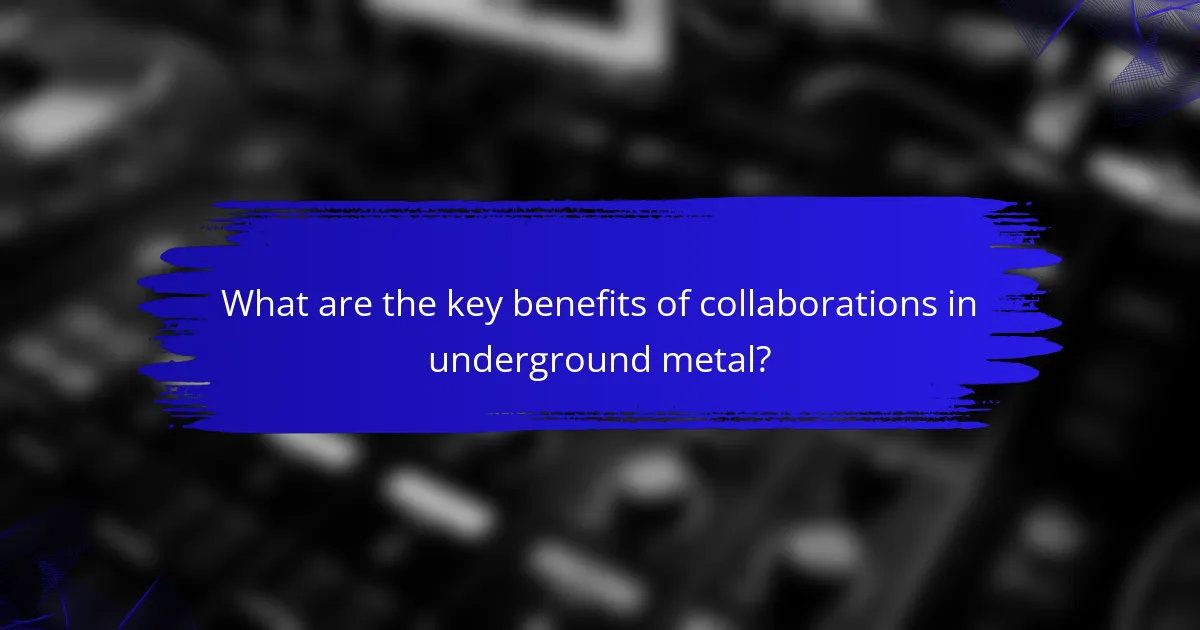
What are the key benefits of collaborations in underground metal?
Collaborations in underground metal offer numerous benefits, enhancing creativity and reach. They foster innovation by blending diverse musical styles, resulting in unique sounds. Collaborations also expand audience bases, introducing bands to new fans. Additionally, they provide networking opportunities, strengthening community ties among artists. Cross-genre projects can lead to fresh perspectives, enriching the underground metal scene overall.
How do collaborations enhance creativity and innovation?
Collaborations in underground metal significantly enhance creativity and innovation by merging diverse musical influences. This cross-pollination leads to unique soundscapes and experimental approaches. Bands that work with producers or other genres often discover new techniques, instrumentation, and lyrical themes. For example, collaborations between metal bands and electronic artists have resulted in innovative blends, expanding the reach and appeal of both genres. Such partnerships foster a dynamic environment where artists push boundaries and inspire each other, ultimately enriching the underground metal scene.
What impact do collaborations have on fan engagement and community building?
Collaborations significantly enhance fan engagement and foster community building in underground metal. By merging diverse musical influences, bands create unique sounds that attract wider audiences. This cross-genre approach encourages collaboration among fans, fostering a sense of belonging.
Collaborations also facilitate the sharing of resources and networks among artists. For instance, joint projects can lead to co-promotions, increasing visibility for all involved. As a result, fans feel more connected to the music and the artists, strengthening community ties.
Moreover, collaborations often result in exclusive content, such as limited releases or unique live performances. This exclusivity drives excitement and engagement within the fan base. Fans are motivated to participate in discussions and share experiences, further solidifying community bonds.
In summary, collaborations in underground metal not only create innovative music but also play a crucial role in enhancing fan engagement and building vibrant communities.
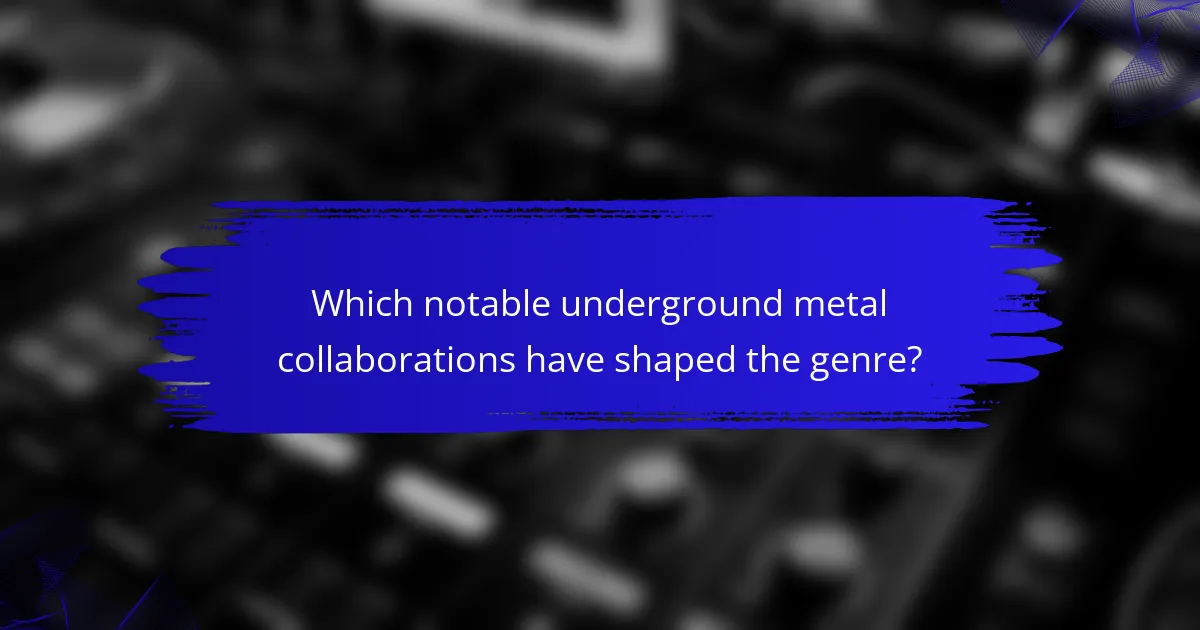
Which notable underground metal collaborations have shaped the genre?
Notable underground metal collaborations have significantly influenced the genre. Bands like Converge and Neurosis have merged hardcore and post-metal, creating unique soundscapes. Projects such as Bloodbath, featuring members from various bands, have shaped death metal’s evolution. Additionally, collaborations with producers like Kurt Ballou have enhanced the raw sound of underground recordings. These partnerships highlight the genre’s diversity and innovation.
What are some cross-genre projects that have emerged from underground metal?
Cross-genre projects in underground metal often feature collaborations between diverse artists, blending various musical styles. Notable examples include the fusion of black metal and electronic music, as seen in the works of artists like Krallice and their experimental soundscapes. Additionally, collaborations with hip-hop artists, such as the partnership between Body Count and Ice-T, showcase metal’s versatility. These projects highlight unique attributes, such as genre-defying creativity and the ability to reach broader audiences. Rare collaborations, like those involving jazz musicians and metal bands, further enrich the underground scene, pushing the boundaries of traditional metal music.
How have regional collaborations influenced the sound of underground metal?
Regional collaborations have significantly enriched the sound of underground metal by blending diverse influences and styles. These partnerships allow bands to experiment and innovate, leading to unique sonic landscapes. For instance, collaborations between metal bands and local artists from different genres introduce fresh elements, enhancing creativity.
Producers also play a vital role in shaping these collaborations. By bringing their expertise and vision, they help bands refine their sound. This cross-pollination often results in albums that defy traditional metal boundaries, showcasing rare attributes that set them apart.
Moreover, regional scenes foster camaraderie and shared resources, allowing underground metal to thrive. These connections can lead to unique events, such as festivals that celebrate various subgenres, further solidifying the community’s influence on sound evolution.
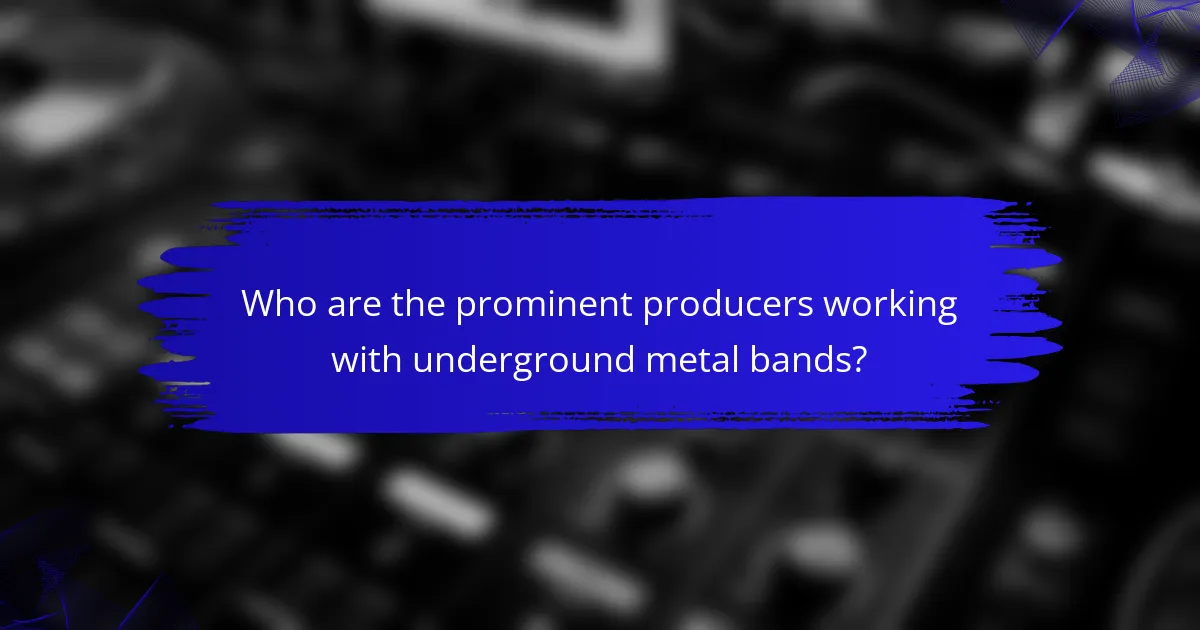
Who are the prominent producers working with underground metal bands?
Prominent producers working with underground metal bands include Kurt Ballou, Scott Burns, and Zeuss. These producers are known for their distinctive sound and ability to elevate the raw energy of underground metal. Kurt Ballou, for instance, is recognized for his work with Converge, blending hardcore punk with metal elements. Scott Burns gained fame for producing classic death metal albums in the 1990s, shaping the genre’s sound. Zeuss has collaborated with various bands across metal subgenres, contributing to their sonic development. Each producer brings unique attributes that enhance the underground metal scene.
What role do producers play in shaping collaborative projects?
Producers play a crucial role in shaping collaborative projects by guiding the creative process and enhancing sound quality. They facilitate communication between band members and help integrate diverse musical influences, particularly in underground metal. Producers often contribute unique attributes, such as innovative recording techniques or genre-blending approaches, which can elevate a project’s overall impact. Their expertise allows for the exploration of cross-genre projects, leading to fresh and experimental sounds that resonate with audiences.
How do producers facilitate cross-genre experimentation?
Producers facilitate cross-genre experimentation by fostering collaboration between diverse musical styles. They create environments that encourage innovation, allowing artists to blend elements from various genres. This process often involves strategic selection of artists, utilizing unique production techniques, and leveraging technology to expand sound palettes. As a result, underground metal bands can explore new musical territories, enhancing their creativity and reach.
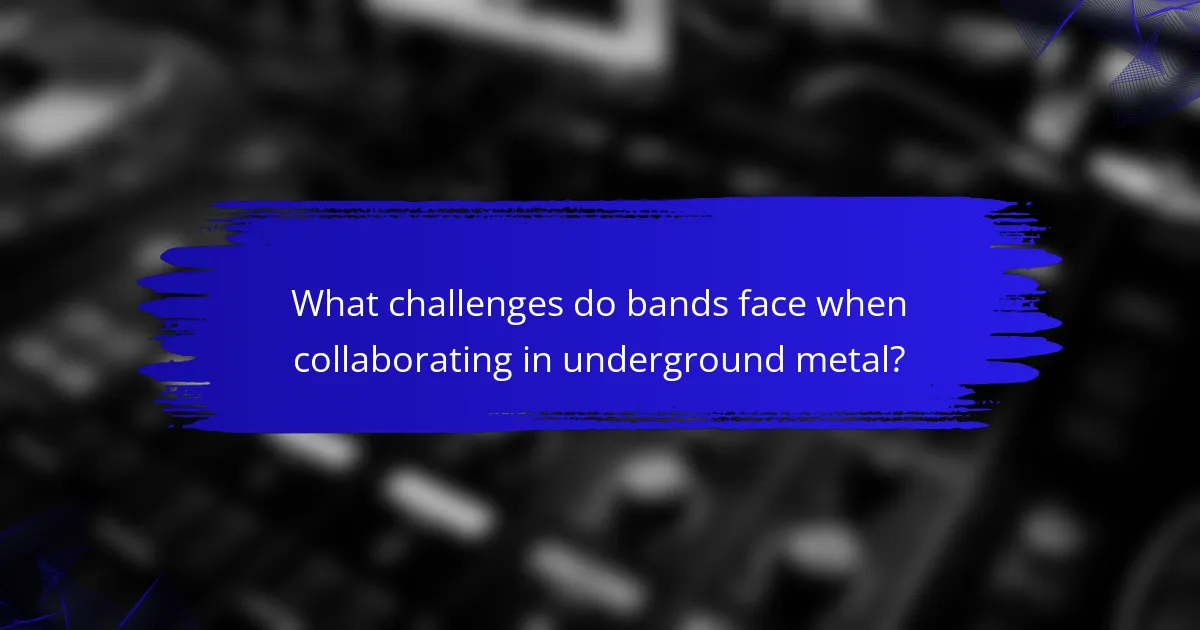
What challenges do bands face when collaborating in underground metal?
Bands in underground metal face challenges like creative differences, limited resources, and varying work ethics. Collaborations often struggle due to mismatched visions, which can hinder artistic cohesion. Additionally, underground scenes may lack access to professional production support, complicating the process. Bands also encounter difficulties in promoting cross-genre projects effectively, as audiences may have specific genre expectations.
How can creative differences impact the outcome of a collaboration?
Creative differences can enhance or hinder collaboration outcomes in underground metal. Diverse perspectives often lead to innovative soundscapes, but conflicting visions may result in tension. Successful collaborations require compromise and clear communication to align artistic goals. Notable examples include cross-genre projects that blend styles, showcasing the potential of creative diversity.
What logistical issues arise during collaborative projects?
Logistical issues during collaborative projects in underground metal often include communication breakdowns, scheduling conflicts, and resource allocation challenges. These obstacles can hinder creative processes and project timelines. For example, differing priorities among bands and producers may complicate decision-making. Additionally, managing diverse musical styles in cross-genre projects can create artistic friction, impacting collaboration quality.
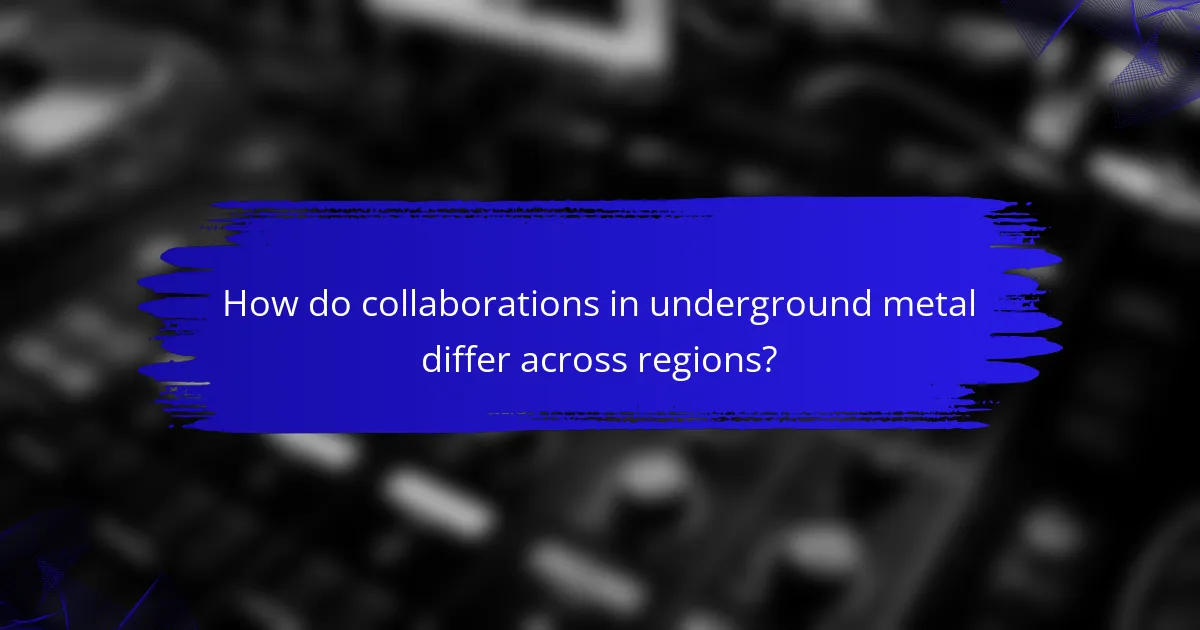
How do collaborations in underground metal differ across regions?
Collaborations in underground metal vary significantly across regions due to cultural influences and musical styles. In Europe, there’s a strong emphasis on blending genres, resulting in innovative cross-genre projects. For instance, Scandinavian bands often incorporate folk elements, creating unique sounds. In contrast, North American collaborations frequently focus on heavy production and technical proficiency, showcasing a different approach to songwriting. Additionally, regional festivals and local scenes foster unique partnerships, enhancing the diversity of underground metal.
What unique attributes characterize collaborations in North American underground metal?
Collaborations in North American underground metal are characterized by a blend of diverse genres, innovative sound experimentation, and strong community ties. Unique attributes include cross-genre projects that merge elements from punk, hardcore, and experimental music, resulting in fresh, boundary-pushing sounds. Collaborations often feature well-known producers who bring distinct production styles, enhancing the final output. Additionally, these partnerships foster a sense of camaraderie among artists, leading to a supportive network that thrives on mutual respect and shared influences.
How do European underground metal collaborations compare in style and execution?
European underground metal collaborations often showcase a unique fusion of styles, reflecting diverse influences. These projects typically blend elements from various subgenres, resulting in innovative soundscapes. Collaborations can involve multiple bands, producers, and cross-genre projects, enhancing creativity and experimentation.
For instance, bands may collaborate across genres, merging black metal with folk or electronic influences. This cross-pollination enriches the underground scene, allowing for fresh interpretations and approaches. The execution of these collaborations often emphasizes raw energy and authenticity, hallmarks of the underground ethos.
Moreover, unique attributes such as regional influences can shape these collaborations. For example, Scandinavian bands may incorporate traditional melodies, while Eastern European groups might emphasize rhythmic complexity. This diversity contributes to a rich tapestry of sound within the European underground metal community.
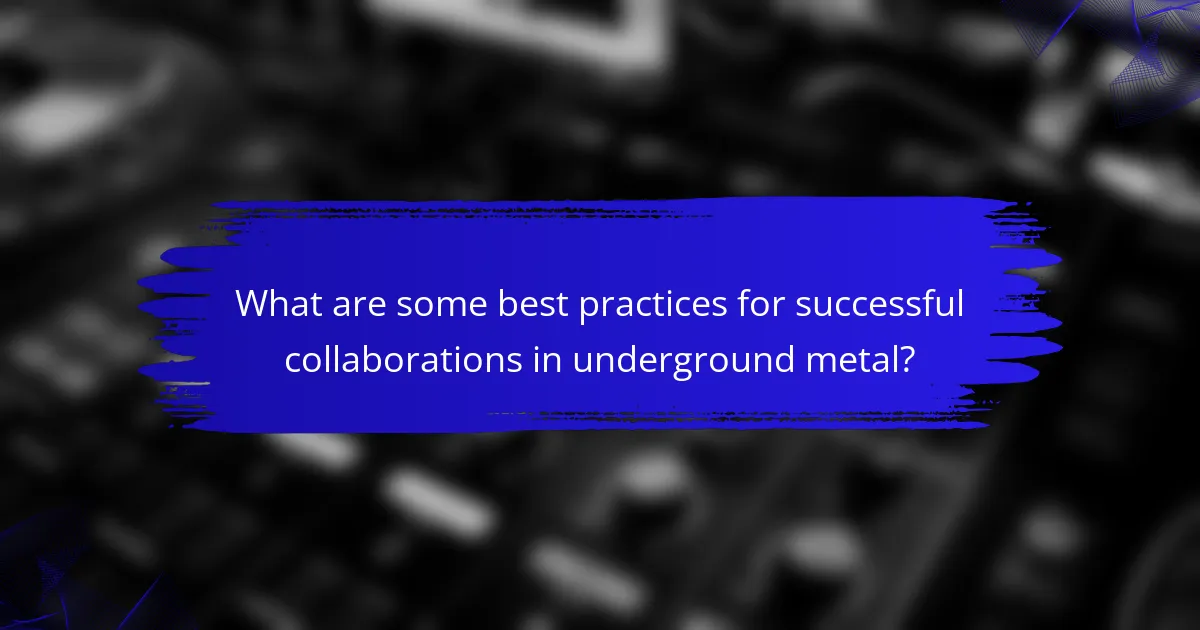
What are some best practices for successful collaborations in underground metal?
Successful collaborations in underground metal require clear communication, mutual respect, and a shared vision. Establishing trust among band members, producers, and collaborators is essential for creativity.
Engaging in cross-genre projects can expand audience reach and introduce fresh influences. For example, metal bands collaborating with electronic artists can create innovative sounds that attract diverse listeners.
Regular rehearsals and open feedback sessions enhance the collaborative process. This practice allows for refining ideas and ensuring everyone’s contributions are valued.
Utilizing social media for promotion can amplify the reach of collaborative projects. Engaging with fans and other artists online fosters community and encourages support for new releases.
How can bands effectively communicate during collaborations?
Effective communication during collaborations requires clarity, openness, and mutual respect. Bands should establish clear roles and expectations to avoid misunderstandings. Regular check-ins can ensure alignment and foster creativity. Utilizing collaborative tools enhances coordination, especially in cross-genre projects. Active listening promotes a supportive environment, encouraging diverse ideas. This approach strengthens relationships and results in innovative outcomes.
What strategies can enhance the collaborative process?
Collaborative processes in underground metal can be enhanced through clear communication, shared goals, and flexibility. Establishing a common vision among bands, producers, and cross-genre projects fosters creativity. Regular feedback loops strengthen relationships and improve outcomes. Utilizing technology for remote collaboration broadens opportunities and facilitates diverse input. Engaging in workshops or jam sessions can lead to innovative ideas and synergy.
What common mistakes should bands avoid in collaborative projects?
Bands should avoid poor communication, unclear roles, lack of creative input, and ignoring deadlines in collaborative projects. Effective collaboration requires clarity and respect for each member’s contributions.
Common mistakes include:
1. Failing to establish clear communication channels.
2. Not defining roles and responsibilities upfront.
3. Overlooking the importance of each member’s creative input.
4. Disregarding deadlines, leading to project delays.
5. Neglecting to address conflicts promptly.
6. Underestimating the impact of differing musical styles.
Addressing these issues can enhance collaboration and lead to successful projects in underground metal.